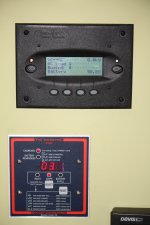Well, I finally got all my panels and inverters hooked up. Took some time because I had to build a structure to hold the panels ( I don't like roof mounts.)
The second photo is the battery box in my basement. I took special care with this. It runs fans off my inverters that kick in when the batteries are charging to remove hydrogen gasses.
The inverters are two Outback VFX3648 pure sine wave. They can run up too 7.2KW and 240 volts to run my well pump. The system is 48 volts. I wanted to run the solar panels at a higher voltage but it gets too cold here in the winter and their open circuit voltage would have exceeded the MPPT's input voltage max.
It's pretty nifty. The system works on the top inverter (the two inverters are in the middle of the photo) When it needs more power the slave inverter kicks in. This saves power. Right now I have it set up to run off the grid if the batteries get below a specific point. This way I always have a good battery reserve if the power goes out here which happens from time to time.
I'm planning on adding a micro-hydro and two home made wind mills and it should run 24/7 with no problems. Right now I have 8-175 watt panels for a total of 1400 watts. With the mills and the hydro it should be over 3,000 watts. Especially in the winter and spring when we get less sunlight but the stream is running well.
So I'm officially off the grid, at least most of the time and it really feels good to be able to shut off the world and notworry about the winter power outages here.
Rob
The second photo is the battery box in my basement. I took special care with this. It runs fans off my inverters that kick in when the batteries are charging to remove hydrogen gasses.
The inverters are two Outback VFX3648 pure sine wave. They can run up too 7.2KW and 240 volts to run my well pump. The system is 48 volts. I wanted to run the solar panels at a higher voltage but it gets too cold here in the winter and their open circuit voltage would have exceeded the MPPT's input voltage max.
It's pretty nifty. The system works on the top inverter (the two inverters are in the middle of the photo) When it needs more power the slave inverter kicks in. This saves power. Right now I have it set up to run off the grid if the batteries get below a specific point. This way I always have a good battery reserve if the power goes out here which happens from time to time.
I'm planning on adding a micro-hydro and two home made wind mills and it should run 24/7 with no problems. Right now I have 8-175 watt panels for a total of 1400 watts. With the mills and the hydro it should be over 3,000 watts. Especially in the winter and spring when we get less sunlight but the stream is running well.
So I'm officially off the grid, at least most of the time and it really feels good to be able to shut off the world and notworry about the winter power outages here.
Rob



